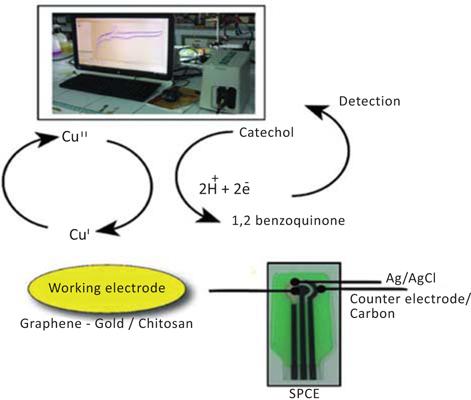Current Analytical Chemistry ( IF 1.8 ) Pub Date : 2020-07-31 , DOI: 10.2174/1573411015666190117114804 Fuzi M. Fartas 1 , Jaafar Abdullah 1 , Nor A. Yusof 1 , Yusran Sulaiman 1 , Mohd I. Saiman 1 , Mohd H.M. Zaid 2

|
Background: Bisphenol A (BPA) is considered one of the most common chemicals that could cause environmental endocrine disrupting. Therefore, there is an increasing demand for simple, rapid and sensitive methods for BPA detection that result from BPA leaching into foods and beverages from storage containers. Herein, a simple laccase electrochemical biosensor was developed for the determination of BPA based on Screen-Printed Carbon Electrode (SPCE) modified graphenegold/ chitosan. The synergic effect of graphene-gold/chitosan nanocomposite as electrode modifier greatly facilitates electron-transfer processes between the electrolyte and laccase enzyme, thus leads to a remarkably improved sensitivity for bisphenol A detection.
Methods: In this study, laccase enzyme is immobilized onto the Screen-Printed Carbon Electrode (SPCE) modified Graphene-Decorated Gold Nanoparticles (Gr-AuNPs) with Chitosan (Chit). The surface structure of nanocomposite was studied using different techniques including Field Emission Scanning Microscopy (FESEM), TRANSMISSION Electron Microscopy (TEM), Raman spectroscopy and Energy Dispersive X-ray (EDX). Meanwhile, the electrochemical performances of the modified electrodes were studied using Cyclic Voltammetry (CV) and Differential Pulse Voltammetry (DPV).
Result: The developed laccase biosensor offered excellent analytical performance for the detection of BPA with a sensitivity of 0.271 μA/μM and Limit of Detection (LOD) of 0.023 μM, respectively. Moreover, the constructed biosensor showed good reproducibility, selectivity and stability towards BPA. The sensor has been used to detect BPA in a different type of commercial plastic products as a real sample and satisfactory result was obtained when compared with the HPLC method.
Conclusion: The proposed electrochemical laccase biosensor exhibits good result which is considered as a promising candidate for a simple, rapid and sensitive method especially in the resource- limited condition.
中文翻译:

基于石墨烯-金/壳聚糖纳米复合膜的漆酶电化学生物传感器检测双酚A
背景:双酚A(BPA)被认为是最常见的可引起环境内分泌干扰的化学物质之一。因此,对由BPA从储藏容器浸入食品和饮料中而导致的用于BPA检测的简单,快速和灵敏的方法的需求日益增长。本文中,基于丝网印刷碳电极(SPCE)修饰的石墨烯/壳聚糖,开发了一种简单的漆酶电化学生物传感器来测定BPA。石墨烯-金/壳聚糖纳米复合材料作为电极改性剂的协同作用极大地促进了电解质和漆酶之间的电子转移过程,从而显着提高了双酚A检测的灵敏度。
方法:在这项研究中,漆酶被固定在带有壳聚糖的丝网印刷碳电极(SPCE)修饰的石墨烯修饰的金纳米颗粒(Gr-AuNPs)上。使用不同的技术研究了纳米复合材料的表面结构,包括场发射扫描显微镜(FESEM),透射电子显微镜(TEM),拉曼光谱和能量色散X射线(EDX)。同时,利用循环伏安法(CV)和差动脉冲伏安法(DPV)研究了修饰电极的电化学性能。
结果:开发的漆酶生物传感器为BPA的检测提供了出色的分析性能,灵敏度分别为0.271μA/μM和0.023μM的检出限(LOD)。此外,构建的生物传感器显示出对双酚A的良好再现性,选择性和稳定性。该传感器已被用于检测不同类型的商品塑料产品中的BPA作为真实样品,与HPLC方法相比获得了满意的结果。
结论:提出的电化学漆酶生物传感器显示出良好的结果,被认为是一种简单,快速和灵敏方法的有希望的候选者,尤其是在资源有限的情况下。



























 京公网安备 11010802027423号
京公网安备 11010802027423号